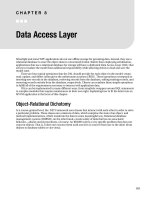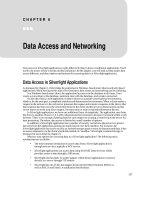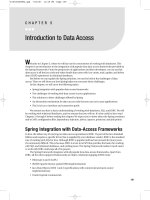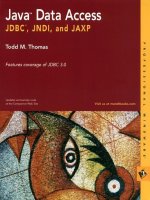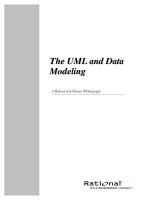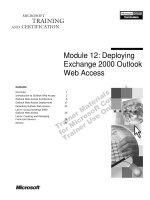Just Spring Data Access ppt
Bạn đang xem bản rút gọn của tài liệu. Xem và tải ngay bản đầy đủ của tài liệu tại đây (6.53 MB, 76 trang )
www.it-ebooks.info
www.it-ebooks.info
Just Spring Data Access
Madhusudhan Konda
Beijing
•
Cambridge
•
Farnham
•
Köln
•
Sebastopol
•
Tokyo
www.it-ebooks.info
Just Spring Data Access
by Madhusudhan Konda
Copyright © 2012 Madhusudhan Konda. All rights reserved.
Printed in the United States of America.
Published by O’Reilly Media, Inc., 1005 Gravenstein Highway North, Sebastopol, CA 95472.
O’Reilly books may be purchased for educational, business, or sales promotional use. Online editions
are also available for most titles (). For more information, contact our
corporate/institutional sales department: 800-998-9938 or
Editors: Mike Loukides and Meghan Blanchette
Production Editor: Iris Febres
Copyeditor: Gillian McGarvey
Proofreader: Iris Febres
Cover Designer: Karen Montgomery
Interior Designer: David Futato
Illustrator: Robert Romano
Revision History for the First Edition:
2012-06-01 First release
See for release details.
Nutshell Handbook, the Nutshell Handbook logo, and the O’Reilly logo are registered trademarks of
O’Reilly Media, Inc. Just Spring Data Access, the image of the channel-billed cuckoo, and related trade
dress are trademarks of O’Reilly Media, Inc.
Many of the designations used by manufacturers and sellers to distinguish their products are claimed as
trademarks. Where those designations appear in this book, and O’Reilly Media, Inc., was aware of a
trademark claim, the designations have been printed in caps or initial caps.
While every precaution has been taken in the preparation of this book, the publisher and authors assume
no responsibility for errors or omissions, or for damages resulting from the use of the information con-
tained herein.
ISBN: 978-1-449-32838-2
[LSI]
1339616491
www.it-ebooks.info
Table of Contents
Foreword . . . . . . . . . . . . . . . . . . . . . . . . . . . . . . . . . . . . . . . . . . . . . . . . . . . . . . . . . . . . . . . . . . . . v
Preface . . . . . . . . . . . . . . . . . . . . . . . . . . . . . . . . . . . . . . . . . . . . . . . . . . . . . . . . . . . . . . . . . . . . . vii
1. Basics . . . . . . . . . . . . . . . . . . . . . . . . . . . . . . . . . . . . . . . . . . . . . . . . . . . . . . . . . . . . . . . . . 1
Using Plain JDBC 1
Spring Data Access 3
Templates 3
MySQL Database Scripts 3
Using JdbcTemplate 4
Summary 13
2. Advanced Concepts . . . . . . . . . . . . . . . . . . . . . . . . . . . . . . . . . . . . . . . . . . . . . . . . . . . . . 15
NamedParameterJdbcTemplate 15
Using Map 16
Using SqlParameterSource 16
Jdbc Batching 17
Using SqlParameterSourceUtils 17
Using BatchPreparedStatementSetter 18
Simple JDBC Classes 19
SimpleJDBCInsert Class 19
SimpleJdbcCall Class 20
In-Memory Databases 21
Callbacks 23
PreparedStatement Callback 23
Callable Statement Callbacks 25
Row Callbacks 26
Summary 27
3.
Hibernate . . . . . . . . . . . . . . . . . . . . . . . . . . . . . . . . . . . . . . . . . . . . . . . . . . . . . . . . . . . . 29
Two-Minute Hibernate 29
iii
www.it-ebooks.info
Using Spring Hibernate 31
Basic Setup 32
Hibernate Operations 35
Using HibernateTemplate 37
Transactions 38
Summary 40
4. Spring JPA . . . . . . . . . . . . . . . . . . . . . . . . . . . . . . . . . . . . . . . . . . . . . . . . . . . . . . . . . . . . 41
Two-Minute JPA 41
Using Spring 43
Standalone Factory 44
Container Factory 45
Transactions 47
Using Plain JPA API 48
Using JpaTemplate 49
Support Classes 51
Summary 51
5.
Spring JDO . . . . . . . . . . . . . . . . . . . . . . . . . . . . . . . . . . . . . . . . . . . . . . . . . . . . . . . . . . . . 53
Spring Support 53
Plain JDO API 54
Persistent Entity 54
Persistence DAO 55
Wiring the Pieces 55
Bytecode Enhancers 56
Example Test 57
Working with JdoTemplate 57
Support Classes 59
JDO versus JPA versus Hibernate 60
Summary 61
iv | Table of Contents
www.it-ebooks.info
Foreword
Reading headlines like “Facebook moves 30-petabyte Hadoop cluster to new data cen-
ter” shows that one of the biggest struggles we are facing today is Big Data and its
management. Data centric applications, mobile front ends to complex data structures,
and serving millions of clients accessing our datasets while handling billions of trans-
actions a day shows that keeping data management simple and easy to handle is a first
class problem in modern application development.
Thankfully, tools like Spring Data and it’s many utilities make it easy to access these
data sets using whichever flavor of standards best fits our team’s skills and needs. While
Java blazed the trail by offering the flexible but consistent JDBC standard, it was the
power of Spring that cut out the tedious amounts of boilerplate afforded to us by his-
torical SQL paradigms. This has empowered developers to focus on business logic,
scaling requirements, mobile platform support, and other numerous requirements
while allowing Spring to handle the chores of managing connections and interacting
with various data management technologies. This is analogous to migrating from the
manual memory management of coding in C to Java’s sophisticated garbage collection,
which removed a whole host of bugs we as developers used to face every day. By re-
ducing the total amount of code we must write to access our own Big Data, we quickly
cut out a huge number of potential bugs on Day One of our own projects.
It is refreshing to read a slim and trim book like Just Spring Data Access, which avoids
the ever popular thick-as-possible approach and instead tries to be as clear and to-the-
point as possible. For the fledgling developer that has just joined a team that uses Spring
Data, this book provides a fantastic means to “catch up” over the weekend and be ready
to dive in on Monday. For an architect trying to choose which standard to use for a
new system, it also provides a quick read, allowing him or her to start their evaluation
with something more concrete than some cobbled together opinions. Finally, for the
more seasoned developer, it provides a good reference to look back and polish up skills
in the arena of data management and the options provided by competing Java stand-
ards. None of us are experts on everything, and having a tightly focused book is often
just what we need to hone in and solve the problems we have.
—Greg Turnquist, Senior Software Engineer at SpringSource, a division of VMware,
and author of Spring Python 1.1
v
www.it-ebooks.info
www.it-ebooks.info
Preface
There are two different worlds: the world where none other than objects are known,
and the world where data is represented in a traditional row-column format. Bringing
these two worlds together is always a cumbersome task, and many times is asking for
trouble. However, we have no option: they must work together!
We have JDBC to some extent, but the intricacies and complexities of persistence of
Java objects to a relational databases was still a greater challenge. The Object Relational
Mapping frameworks—Hibernate being the most popular open source framework—
has taken away a lot of pain and grief from the developer. Spring framework has gone
one more step further to simplify the usage even further.
This book in an attempt in bringing the framework closer to the developer. With simple
and plain language, along with easy to understand examples, this book covers just the
required bits for data access in a Java world.
This book covers JDBC, Hibernate, JPA, and JDO, as well as Spring’s take on these
technologies.
My goal is to deliver simple, straight-to-the-point explanations with intuitive, example-
driven, engaging books! If you pick up the book, you should finish it in a day or two
at most!
I sincerely believe that one will gain adequate knowledge and ammunition after reading
this book.
One would require the basic understanding of Java and Spring Framework as a pre-
requisite to this book. I am expecting you to enjoy this simple read. Please do get in
touch even if you are unsatisfied with my writings.
If you are in London, ping me (and perhaps buy me a coffee) for a meetup. Additionally,
I am easily accessible via email () or via Twitter
(@mkonda007).
vii
www.it-ebooks.info
Conventions Used in This Book
The following typographical conventions are used in this book:
Italic
Indicates new terms, URLs, email addresses, filenames, and file extensions.
Constant width
Used for program listings, as well as within paragraphs to refer to program elements
such as variable or function names, databases, data types, environment variables,
statements, and keywords.
Constant width bold
Shows commands or other text that should be typed literally by the user.
Constant width italic
Shows text that should be replaced with user-supplied values or by values deter-
mined by context.
This icon signifies a tip, suggestion, or general note.
This icon indicates a warning or caution.
Using Code Examples
This book is here to help you get your job done. In general, you may use the code in
this book in your programs and documentation. You do not need to contact us for
permission unless you’re reproducing a significant portion of the code. For example,
writing a program that uses several chunks of code from this book does not require
permission. Selling or distributing a CD-ROM of examples from O’Reilly books does
require permission. Answering a question by citing this book and quoting example
code does not require permission. Incorporating a significant amount of example code
from this book into your product’s documentation does require permission.
We appreciate, but do not require, attribution. An attribution usually includes the title,
author, publisher, and ISBN. For example: “Just Spring Data Access by Madhusudhan
Konda (O’Reilly). Copyright 2012 Madhusudhan Konda, 978-1-449-32838-2.”
If you feel your use of code examples falls outside fair use or the permission given above,
feel free to contact us at
viii | Preface
www.it-ebooks.info
Safari® Books Online
Safari Books Online (www.safaribooksonline.com) is an on-demand digital
library that delivers expert content in both book and video form from the
world’s leading authors in technology and business.
Technology professionals, software developers, web designers, and business and cre-
ative professionals use Safari Books Online as their primary resource for research,
problem solving, learning, and certification training.
Safari Books Online offers a range of product mixes and pricing programs for organi-
zations, government agencies, and individuals. Subscribers have access to thousands
of books, training videos, and prepublication manuscripts in one fully searchable da-
tabase from publishers like O’Reilly Media, Prentice Hall Professional, Addison-Wesley
Professional, Microsoft Press, Sams, Que, Peachpit Press, Focal Press, Cisco Press, John
Wiley & Sons, Syngress, Morgan Kaufmann, IBM Redbooks, Packt, Adobe Press, FT
Press, Apress, Manning, New Riders, McGraw-Hill, Jones & Bartlett, Course Tech-
nology, and dozens more. For more information about Safari Books Online, please visit
us online.
How to Contact Us
Please address comments and questions concerning this book to the publisher:
O’Reilly Media, Inc.
1005 Gravenstein Highway North
Sebastopol, CA 95472
800-998-9938 (in the United States or Canada)
707-829-0515 (international or local)
707-829-0104 (fax)
We have a web page for this book, where we list errata, examples, and any additional
information. You can access this page at:
/>To comment or ask technical questions about this book, send email to:
For more information about our books, courses, conferences, and news, see our website
at .
Find us on Facebook: />Follow us on Twitter: />Watch us on YouTube: />Preface | ix
www.it-ebooks.info
Acknowledgments
I sincerely wish to thank my editors, Mike Loukides and Meghan Blanchette, and to
all of those at O’Reilly, especially Iris Febres for helping shape this book.
I also sincerely express my deepest gratitude to Greg Turnquist for his guidance
throughout the project.
A big thanks to goes to my family, especially to my loving wife, Jeannette, for being
very patient and supportive. Also to my loving five-year-old son, Joshua, who sacrificed
his free time, allowing me to write when I explained to him what I was doing in return
for a trip to Disneyland!
I also thank my family in India for their wonderful support and love.
This book was written in memory of my loving Dad—we all miss you, Dad!
x | Preface
www.it-ebooks.info
CHAPTER 1
Basics
Persistence of data is a challenging task for developers. There are many things that could
go wrong. The introduction of JDBC has given the developer community a bit of joy
by taking away painstakingly cumbersome database access in Java applications. How-
ever, there are a few wrinkles that come with JDBC, such as having to write boilerplate
code, finding out a clue from the SQLExcetion stacktrace, resource management, and
so on.
Spring has gone further in simplifying the data access by providing a simple and
straightforward framework. This chapter discusses Spring’s take on JDBC, and how
Spring simplified the JDBC programming model; it did so by employing simple yet
powerful mechanisms, such as Dependency Injection, Templates, and other patterns.
Using Plain JDBC
With the advent of JDBC, accessing data from a Java application has become relatively
easy. Not only do we have independence from database vendor lock-in, but we also
have a standard API to access multitude of databases.
However, the steps involved in using a JDBC are always the same—obtain a connection,
create a Statement, execute a query, run it through ResultSet, and release the resources.
The following code demonstrates a simple example of selecting the TRADES data using
plain JDBC:
public class JdbcPlainTest {
private String DB_URL="jdbc:mysql://localhost:3306/JSDATA";
private final String USER_NAME = "XXXX";
private final String PASSWORD = "XXXX";
private Connection createConnection() {
Connection conn = null;
try {
Class.forName("com.mysql.jdbc.Driver");
conn =
1
www.it-ebooks.info
DriverManager.getConnection(DB_URL, USER_NAME,PASSWORD);
} catch (ClassNotFoundException e) {
e.printStackTrace();
} catch (SQLException e) {
e.printStackTrace();
}
return conn;
}
private void query() {
ResultSet rs = null;
Statement stmt = null;
Connection conn = createConnection();
try {
stmt = conn.createStatement();
rs = stmt.executeQuery("SELECT * FROM TRADES");
while (rs.next())
System.out.println(rs.getString(1));
} catch (SQLException e) {
e.printStackTrace();
} finally {
try {
rs.close();
stmt.close();
conn.close();
} catch (SQLException ex) {
e.printStackTrace();
}
}
}
public static void main(String args[]) {
JdbcPlainTest t = new JdbcPlainTest();
t.query();
}
}
Phew! That’s a lot of code for a simple task! Did you notice the code around exceptions?
There are a few things that you could have noticed from the above example:
• The resource management (creating and closing connections and statements) is a
repetitious process.
• The SQLException must be caught in both the creation and destruction processes.
• The actual business logic is not more than a couple of lines; unfortunately, code is
cluttered with lot of JDBC API statements and calls.
We can create a home-grown framework with callbacks and handlers to resolve these
issues. Although it does work, creating your own framework leads to several issues—
maintenance, extending to suit newer requirements, extensive testing, and others.
2 | Chapter 1: Basics
www.it-ebooks.info
If there’s already a framework that does this work, why reinvent the wheel?
The Spring data access framework is specifically created to address these problems. It
is a beautiful framework that promotes Dependency Injection principles and carries
multiple features.
Spring Data Access
The Spring data access framework has made the developer’s job very easy!
It creates a rich framework in which, or from which to access databases by decoupling
our code from the access mechanisms. As always, the framework heavily uses Depend-
ency Injection patterns, so decoupling of our code really comes to life. The components
using framework’s API are easily testable, too. Moreover, there’s no exceptions that we
should have to catch when using the APIs!
The access logic revolves around Template patterns and Support classes. These patterns
hide away all the boilerplate code and allows the developer to concentrate solely on
business logic.
Templates
From the previous example, we can see that there is a lot of code that’s not central to
business function. It would be ideal to wrap up the non-critical code away from our
business code in a separate class. Spring’s JdbcTemplate class does exactly that.
This class wraps up all the access logic so users only need to concentrate on the heart
of the application. If you understand the workings of JdbcTemplate, I would say you’ve
conquered most of Spring’s data access workings.
In addition to the standard JdbcTemplate, there are two other variations of the Template
class: SimpleJdbcTemplate and NamedParameterJdbcTemplate. These two varieties are
nothing but wrappers around JdbcTemplate that are used for special cases. We will
discuss all of these in the coming sections. Before we work out examples, we have to
carry out some prerequisites such as creating a database schema and prepopulating test
data.
If you already have a database in place, you can skip this section without any concern.
MySQL Database Scripts
I am using MySQL as the database for all of the examples provided in this book. Setting
up the database is easy if you follow the instructions from the provider carefully.
Once you have MySQL set up, make sure you run the SQL scripts provided by the
book’s source code. These scripts will create a database called JSDATA and create nec-
essary tables such as ACCOUNTS, TRADES, PRICES, and others. If you are working with some
Templates | 3
www.it-ebooks.info
other database, you should be able to run the scripts without any issues; personally, I
have not tested them.
The next important thing is to create a DataSource. The DataSource encapsulates the
database provider information and hence acts like a connection factory by fetching
connections to talk to the database. It should be created by driver information such as
URL, username, password, and other information. Make sure that you supply the nec-
essary provider (driver) information to construct a DataSource if you are using any other
databases.
The datasource-beans.xml file shown below creates a DataSource for MySQL database:
<bean id="mySqlDataSource" class="org.apache.commons.dbcp.BasicDataSource"
destroy-method="close">
<property name="driverClassName" value="com.mysql.jdbc.Driver" />
<property name="url" value="jdbc:mysql://localhost:3306/JSDATA" />
</bean>
The class attribute points to an implementor of the DataSource interface; in the above
snippet, it is a BasicDataSource class from Apache Common’s DBCP project. The
driverClassName points to a class that will be specific to a database.
We will see the full definition in a minute.
Throughout the book, we will use DBCP datasource, which can be downloaded from
the site: If you are using Maven, add the snippet to
your pom.xml file (check out the full pom.xml provided with the book’s source code)
to include DBCP and MySQL connector jars:
<! pom.xml >
<dependency>
<groupId>commons-dbcp</groupId>
<artifactId>commons-dbcp</artifactId>
<version>1.4</version>
</dependency>
<dependency>
<groupId>mysql</groupId>
<artifactId>mysql-connector-java</artifactId>
<version>5.1.18</version>
</dependency>
Using JdbcTemplate
The JdbcTemplate is a framework class utilized for data access operations such as quer-
ies, inserts, and deletes. It is the fundamental class in the framework, so we dwell on it
in detail here.
Note that the JdbcTemplate is a thread safe class—it can be easily shared across your
threads. One of the biggest advantages in using the JdbcTemplate is its ability to clean
up resources. Most developers forget to close the JDBC connections and other related
4 | Chapter 1: Basics
www.it-ebooks.info
resources, which leads to lots of issues. JdbcTemplate comes to our rescue in doing the
house cleaning job for us!
Before we work with JdbcTemplate, we must set the DataSource first. This is a mandatory
requirement that JdbcTemplate be configured with a DataSource object so the template
will be able to create connections and statements behind the scenes.
Configuring a DataSource
As we have already seen, the javax.sql.DataSource is an interface that determines the
connection details for a particular provider. Each provider will have their own imple-
mentation of the class, usually provided in a Jar file. The MySQL driver class is defined
by the com.mysql.jdbc.Driver class, for example.
The following configuration shows how to set up a data source for MySQL:
<?xml version="1.0" encoding="UTF-8"?>
<beans xmlns=" /> xmlns:xsi="
xmlns:context=" /> xsi:schemaLocation="
/>
/> <! MySql DataSource >
<bean id="mySqlDataSource" class="org.apache.commons.dbcp.BasicDataSource">
<property name="driverClassName" value="com.mysql.jdbc.Driver"/>
<property name="url" value="jdbc:mysql://localhost:3306/JSDATA"/>
<property name="username" value="jsuser"/>
<property name="password" value="jsuser"/>
</bean>
</beans>
The above snippet will create a bean named mySqlDataSource that points to a MySQL
database running on localhost, directed by the url property. If we are using other pro-
viders, we need to create another bean with the same properties, but with appropriate
values relevant to our provider.
Configuring JdbcTemplate
Now that the data source has been configured, the next step is to create and work with
the JdbcTemplate class.
There are couple of ways to create this class. One is to create an instance in your class
and provide a preconfigured data source, and the other is to create and instantiate the
bean in the configuration file and inject it into your Data Access Object (DAO) classes.
The DAOs are the classes that talk to databases in order to fulfill the data access func-
tions.
Templates | 5
www.it-ebooks.info
Let’s see an example of instantiating JdbcTemplate with a preconfigured DataSource.
public class JdbcTemplateTest {
private ApplicationContext ctx = null;
private JdbcTemplate template = null;
private DataSource datasource = null;
public JdbcTemplateTest() {
// Create a container forming the beans from datasource XML file
ctx = new ClassPathXmlApplicationContext("datasources-beans.xml");
// DataSource bean has been fetched from the container
datasource = ctx.getBean("mySqlDataSource",DataSource.class);
// Instantiate the template with the datasource
template = new JdbcTemplate(datasource);
}
public static void main(String[] args) {
JdbcTemplateTest t = new JdbcTemplateTest();
// execute the data access methods from here
}
}
The steps are simple:
• Load and fetch the context from a config file that consists of datasources (in our
case, it’s the datasouces-beans.xml)
• Create the JdbcTemplate using the new operator providing the datasource bean to
its constructor
Once you have the JdbcTemplate fully configured and functional, you are ready to use
it to access our databast tables. The JdbcTemplate has a lot of functionality that requires
a bit of detail study.
Working with JdbcTemplate
The JdbcTemplate has more than 100 methods that give varied access to data sets!
For example, you may wish to execute straight queries such as inserting data or creating
tables. You can use the execute() method exposed on the JdbcTemplate for such actions.
Likewise, if you wish to query for single or multiple data rows, you should be using
queryForXXX methods. There are lots of other methods, some of them are self explana-
tory and others are easy to follow using JavaDoc. We will cover the most important of
all of these methods in the coming sections.
Let’s say our requirement is to find out the number of
rows present in the TRADES table.
Querying for Single and Multiple Rows.
6 | Chapter 1: Basics
www.it-ebooks.info
The following snippet shows the usage of JdbcTemplate in its simplest form—for fetch-
ing the number of TRADES in the table:
public int getTradesCount(){
int numOfTrades =
template.queryForInt("select count(*) from TRADES");
return numOfTrades;
}
The queryForInt() method returns the count(*) equivalent from the table. The return
type is obviously an integer. There are few variants of queryForXXX methods such as
queryForString, queryForLong, queryForMap, and queryForObject. Basically, these are
facility methods that convert your column value to an appropriate data type.
You can also rewrite the above example by using the more generic queryForObject
method. However, the method takes a second parameter, which basically describes the
return value’s data type. In our example, because count(*) will return an integer, we
pass the Integer class to the method call.
This is illustrated below:
public int getTradesCount(){
int numOfTrades =
template.queryForObject("select count(*) from TRADES",Integer.class);
return numOfTrades;
}
// Another example of get the max id of the
// trade using queryForObject method
public int getTradeMaxId(){
int maxId =
template.queryForObject("select max(id) from TRADES", Integer.class);
return maxId;
}
The above snippet also provides another example of using the queryForObject method
to query for a Trade that has a maximum id. The queryForLong and queryForString
follow the same pattern, returning a Long and String value, respectively.
The queryForMap returns a single row in a Map<String,Object> format as shown below:
public Map<String,Object> getTradeAsMap(){
// note that we have hardcoded ID here!
Map<String,Object> tradeAsMap =
template.queryForMap("select * from TRADES where id=1");
System.out.println("Trades Map:"+tradeAsMap);
return tradeAsMap;
}
Templates | 7
www.it-ebooks.info
//The output to the console is:
Trades Map:{ID=1, ACCOUNT=1234AAA, SECURITY=MDMD,
QUANTITY=100000, STATUS=NEW, DIRECTION=BUY}
As you can see, each column name is the key represented by String while the value is
represented by the Object in the Map<String,Object> declaration.
However, the queryForList is a bit different to others in that it can return multiple rows.
The rows are returned as a List of Map<String,Object> format.
Let’s see this at work. The getAllTrades() method fetches all of the trades and prints
out to the console:
public List<Map<String,Object>> getAllTrades(){
List<Map<String,Object>> trades =
template.queryForList("select * from TRADES");
System.out.println("All Trades:"+trades);
return trades;
}
//Prints to console as:
All Trades:
[{ID=1, ACCOUNT=1234AAA, STATUS=NEW, DIRECTION=BUY},
,
{ID=5, ACCOUNT=452SEVE, STATUS=NEW, DIRECTION=SELL}]
The queries that we used in the above examples are fairly simple. We can also write
complex queries that can be executed in the same fashion. We often use where clauses
and other SQL constructs to execute complex queries. However, the where clause re-
quires input variables to be set. How can we parameterize these bind variables?
Bind variables help to create a dynamic SQL query. If our requirement is
to fetch records based on various conditions, we usually use the where clause in our
SQL script. Bind variables are the preferred option as opposed to using inline variables
because they protect our application against SQL injection attacks.
For example, if we have to get the STATUS of a Trade whose id is 5, we need to write the
SQL as follows:
public String getTradeStatus(int id){
String status =
template.queryForObject("select STATUS from TRADES where id= ?",
new Object[]{id}, String.class);
return status;
}
Bind Variables.
8 | Chapter 1: Basics
www.it-ebooks.info
The ? will be an indication to the framework to substitute the value with the second
parameter of the method, which in the above case is the id. The way to do this is to
create an array of Object with your incoming id value. The third parameter is the type
of value the method query is expected to return; in this case, the STATUS is a String type.
We can provide more than a one bind variable, no restriction on the number.
In the following snippet, the overloaded getTradeStatus() method has two conditions
in the where clause and accordingly, we provide a second value via a second parameter,
Object array:
public String getTradeStatus(int id, String security){
String status =
template.queryForObject("select STATUS from TRADES where id = ? and security=?",
new Object[]{id,security}, String.class);
return status;
}
We know that each row in the TRADES table is represented
by our Trade domain object. Although we have seen fetching the Trades from the table,
we have not yet seen how we create a Trade object from each row of the record.
In order to do this, we need to use a RowMapper callback provided by the framework.
The RowMapper interface has one method—mapRow—where you need to map the in-
coming row to the domain object. You can create the RowMapper as an anonymous class
or you can have your own class implementing the RowMapper interface separately.
Let’s take a look at each one separately.
First, we create a TradeMapper class that implements the RowMapper interface and defines
its single method:
private static final class TradeMapper implements RowMapper<Trade>{
@Override
public Trade mapRow(ResultSet rs, int rowNum) throws SQLException {
Trade t = new Trade();
// set the values by use ResultSet's getXXX methods
t.setId(rs.getInt("ID"));
return t;
}
}
In the mapRow method, a ResultSet instance for the current row is given to us via this
callback. What we are doing is extracting the column data from the ResultSet object
and setting the values against our newly instantiated domain object Trade. The method
then retuns the fully initialized Trade object.
As we now have our RowMapper implementation ready, we give it to the overloaded
queryForObject method to retrieve all the trades from the table:
Mapping Rows to Domain Objects.
Templates | 9
www.it-ebooks.info
public Trade getMappedTrade(int id){
Trade trade = template.queryForObject("select * from TRADES where id = ?",
new Object[]{id} ,
new TradeMapper());
return trade;
}
Did you notice the third argument to the method? It’s taking our TradeMapper class,
which creates the Trade with the column values extracted from the ResultSet. The good
thing about this callback class is that we can use it anywhere that a method expects a
RowMapper to convert the column data to Trade object.
There’s an alternative way of using RowMapper—we can also use an anonymous class to
create a RowMapper instead of creating a separate instance as we have seen above. The
way to do so is illustrated below:
public Trade getTrade(int id){
Trade trade = template.queryForObject("select * from TRADES where id= ?",
new Object[]{id},
new RowMapper<Trade>(){
@Override
public Trade mapRow(ResultSet rs, int row) throws SQLException {
Trade t = new Trade();
t.setId(rs.getInt("ID"));
t.setAccount(rs.getString("ACCOUNT"));
t.setDirection(rs.getString("DIRECTION"));
return t;
}
});
return trade;
}
The RowMapper that is instantiated inline as an anonymous class does exactly the same
thing that we saw earlier.
Note that second argument in the mapRow corresponds to the row number of the record
given to the callback. Also, keep in mind that the ResultSet given to your callback has
only one record. Any use of ResultSet.next() will throw a SQLException.
Creating the RowMapper class anonymously has a limited scope—it can’t be used any-
where else in the application. Unless you have a strong case to use the anonymous class,
go with a separate class like TradeMapper and reuse it. Reusability scores good marks!
Note that both the JdbcTemplate and RowMapper classes are thread safe. You can share
them and use them across threads without having to worry about state corruption.
Now that we know how to fetch a single record and map to a do-
main object, let’s see how to get the list of all rows mapped to domain objects. Actually,
it is quite straight forward now that you have a RowMapper class already designed.
Fetching List of Trades.
10 | Chapter 1: Basics
www.it-ebooks.info
The following snippet is used to fetch such a list. Note that the only change was using
query() method rather than queryForXXX method:
public List<Trade> getAllMappedTrades(){
List<Trade> trades =
template.query("select * from TRADES", new TradeMapper());
return trades;
}
For each row fetched, a respective Trade object will be formed by the TradeMapper and
then added to the list—simple!
Now that you’ve seen various query mechanisms, let’s look at the update and delete
workings, too.
Inserting, Deleting, and Updating Rows
We also use the JdbcTemplate to do the updates. We use JdbcTemplate.update() variants
to execute the appropriate statements. The following snippet shows inserting a Trade
into TRADES table:
private void insertTrade() {
int rowsUpdated =
template.update("insert into TRADES values(?,?,?,?,?,?)",
61,"JSDATA","REV",500000,"NEW","SELL");
System.out.println("Rows Updated:"+rowsUpdated);
}
The return value indicates the rows affected. Note that we use bind variables in the
above query.
Similarly, use the same update method to update the values of the rows. The following
example shows how to update the status of an existing Trade:
private void updateTrade(String status, int id) {
int rowsUpdated =
template.update("update TRADES set status='"+status+"' where id="+id+"");
System.out.println("Rows Updated:"+rowsUpdated);
}
The above statement looks a little bit ugly with all the String concatenation. Is there
any other way of doing this job?
There is a way. You can use the another variant of the update method that takes varargs:
private void updateTrade(String status, int id) {
int rowsUpdated =
template.update("update TRADES set status=? where id=?",status, id);
Templates | 11
www.it-ebooks.info
System.out.println("Rows Updated:"+rowsUpdated);
}
There’s another overloaded method that sets the bind variables using an Object array
(which we have already seen in our query examples earlier) and java.sql.Types array.
The types array will provide the necessary framework tools to typecast the variables.
In the following updateTradeUsingTypes method, we are using the types array to let the
framework know the bind values type. However, as the status and id are already known
types, perhaps using the types array might not be needed except for the compiler’s sake.
private void updateTradeUsingTypes(String status, int id) {
int rowsUpdated = template.update(
"update TRADES set status=? where id=?",
new Object[] { status, id },
new int[] { java.sql.Types.VARCHAR, java.sql.Types.INTEGER });
System.out.println("Rows Updated:" + rowsUpdated);
}
However, see the updated snippet below where using SQL types comes necessary—we
pass in all the arguments as String objects.
private void updateTradeUsingTypes() {
int rowsUpdated = template.update(
"update TRADES set status=? where id=?",
new Object[] { "UNKNOWN","6" },
new int[] { java.sql.Types.VARCHAR,java.sql.Types.INTEGER });
System.out.println("Rows Updated:" + rowsUpdated);
}
You can also invoke a Stored Procedure using the update method, as shown here:
private void replayTradesUsingSP(List tradeIds) {
template.update(
"call JSDATA.REPLAY_TRADES_SP (?)", tradeIds);
}
The REPLAY_TRADES_SP stored procedure picks up all the trades identified by the trade
Ids list and replay them.
Executing Statements
The JdbcTemplate exposes execute methods so you can run Data Definition Language
(DDL) statements easily:
public void createAndDropPersonTable(){
template.execute("create table PERSON
(FIRST_NAME varchar(50) not null, LAST_NAME varchar(50) not null)");
// drop the table
template.execute("drop table PERSON");
12 | Chapter 1: Basics
www.it-ebooks.info
System.out.println("Table dropped");
}
Summary
In
this chapter, we began the problem statement by discussing the wrinkles around
Java database programming using standard JDBC APIs. We identified the boiler plate
code around the usage in relation to the resource management and jumped to see what
Spring’s framework has done to address them. The Spring’s framework has wrapped
up the unnecessary boilerplate code into templates. We have seen the fundamental
class of the framework—JdbcTemplate—in action. We learned how to utilize the class
using simple examples.
The next chapter will discuss the additional templates along with advanced Spring
JDBC usage using Support classes and callbacks.
Summary | 13
www.it-ebooks.info

